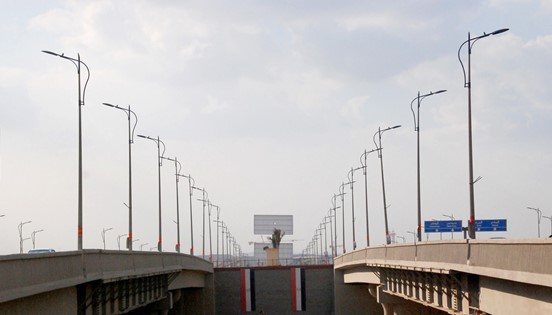Our fiberglass poles are light in weight, easy to install and maintenance-free. As non-conductors of electricity they also offer a higher degree of safety. From our factories in Egypt, we can produce fiberglass poles up to 14 meters long, in different arm types and colors, with a choice of direct burial or anchor base. Please download our Fiberglass Poles catalogue for full specifications.
One of our specialties is solar powered street lighting. PV-solar lights have virtually zero running costs and maintenance. They can be erected in almost any location, are unaffected by power outages or surges and will not need replacing for many years. We can provide steel or fiberglass lighting poles in a wide choice of design and length. They also be retrofitted or integrated into existing structures. See our Solar catalogue for more details.
Applications:
- Street lighting
- Decorative & garden lighting
- Wide areas
- Traffic signs
- Signal carrying
- Flagpoles
- Overhead transmission (up to 11 kV)
Projects

90th Street Bridge, New Cairo, Egypt

El-Musheer Mosque, New Cairo, Egypt

Smart Village, Giza, Cairo

Cairo Alexandria Highway, Egypt

El-Salam Road, Sharm El-Sheikh, Egypt
.jpg)
King Abd El-Aziz Seaport, Dammam, KSA

El-Riyad Metro Project, KSA
Structured cabling is the passive infrastructure that supports the transmission of data, voice, and video signals in a building or campus. It consists of various components, including twisted pair cables, fiber optic cables, and cable accessories. Twisted pair cables are the most common type of cabling used in structured cabling systems. They are composed of two insulated copper conductors that are twisted together to reduce electromagnetic interference (EMI). The most common types of twisted pair cables used in structured cabling are UTP (Unshielded Twisted Pair) and FTP (Foiled Twisted Pair). Fiber optic cables are another type of cabling used in structured cabling systems. They are made up of glass or plastic cores that transmit light signals. Fiber optic cables are generally used for long distances or high-bandwidth applications.
Structured cabling systems typically include a variety of components, such as closures, patch panels, outlets, modules, racks, and cabinets. Closures are used to terminate and splice cables. Patch panels are used to connect cables to other network devices. Outlets are used to provide access to the network for end users. Modules are used to connect cables to patch panels. Racks and cabinets are used to house and organize cabling components. The type of cabling and components used in a structured cabling system will depend on the specific needs of the network.